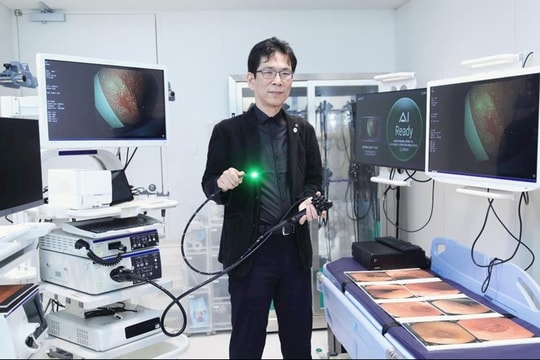How does Japan apply technology in disaster prevention?
Japan is a country that regularly suffers from natural disasters such as earthquakes, tsunamis and typhoons. However, thanks to the application of modern technology, this country has significantly reduced the damage caused by natural disasters.
Natural disasters are becoming an increasingly serious threat around the world, from earthquakes, tsunamis, volcanic eruptions to heavy rains, floods, landslides and snowstorms. Japan, a country that has suffered severe natural disasters many times.

Therefore, this country constantly researches and applies advanced technologies to minimize risks and protect people and infrastructure.
Early warning system and manual for quick and safe evacuation
Since 2007, Japan has pioneered the integration of an earthquake early warning system on smartphones. When detecting small tremors that appear seconds or tens of seconds before a major earthquake, the system will immediately issue an emergency warning, giving people time to prepare and find safe shelter.
This is the world's first early warning system, using data from more than 690 monitoring stations of the Japan Meteorological Agency and about 1,000 seismic measuring points of the National Institute of Earth Science and Disaster Prevention.
In addition to earthquake warnings, smartphones in Japan also come with Disaster Bulletin Board Services and many other emergency support applications from network providers.
Users can quickly notify their family and friends of their safety status. In particular, Japan has developed an application that provides disaster information specifically for foreign tourists, helping them receive emergency updates completely free of charge.

Local governments are also taking the initiative in disaster prevention. In Tokyo, the government has published a disaster handbook called “Tokyo Bosai” that provides important survival tips in the event of an earthquake or other natural disaster.
The booklet is distributed free of charge to each household and is available on the official website of the Tokyo Metropolitan Government in multiple language versions including English, Chinese and Korean.
When the Gyeongju earthquake struck South Korea in 2016, the Korean version of this book quickly became a hot topic on social media, demonstrating the great influence of the disaster prevention measures that Japan is applying.
Using drones and robots in rescue operations
Drones are playing an increasingly important role in disaster prevention and rescue.
Currently, Japan is focusing on developing specialized drones to support rescue in emergency situations.
One of the most advanced technologies is the "Third Eye" drone system, equipped with thermal infrared sensors that detect trapped people through heat signals emitted from the body.
This technology allows the victim's location to be displayed as a hologram, helping rescuers easily determine their location and condition even in limited visibility conditions such as at night or when there is thick smoke.
Data collected from the drone is transmitted directly to rescue teams, helping them reach victims quickly, avoiding wasting precious time in critical situations. The system has undergone many real-life tests and is expected to be officially deployed in fire and police departments soon.

Besides drones, Japan is also developing rescue robots to assist in dangerous tasks that are difficult for humans to perform.
One of the most advanced devices is the Quince rescue robot, designed to penetrate dangerous areas such as collapsed buildings, tunnel systems or underground infrastructure.
With its flexible design and ability to operate in harsh environments, Quince can collect data, inspect damage and locate trapped people without sending rescuers into high-risk areas.
The robot has been successfully deployed in many disasters, including major earthquakes, helping to minimize casualties among rescue teams and improve the efficiency of searching for victims.
The combination of modern drone technology and rescue robots not only helps speed up the rescue process but also improves accuracy and safety for both victims and rescuers.
In the future, these technologies promise to continue to improve and become an indispensable part of disaster prevention work in Japan.
Using new technology to predict sudden localized heavy rains and tsunami damage
Sudden localized downpours in Japan are often intense and difficult to predict, but a free app has been developed to help warn of them.
This application uses a modern 3D radar system, capable of measuring the development of convective clouds in different layers, combined with traditional radar technology to detect signs of forming local storms. Thanks to that, users can receive early warnings of the risk of heavy rain, helping them proactively prevent floods and flash floods.
In addition, Japan is also applying advanced technology to assess damage caused by tsunamis after large-scale earthquakes.
An analysis system led by Tohoku University has been developed to rapidly determine the height, area of influence and extent of damage to structures hit by tsunamis.
The system not only estimates the number of people in the affected area, but also compiles damage data and distributes detailed information within just 30 minutes of a tsunami occurring.
This helps rescue forces get critical data immediately, thereby deploying relief operations more quickly and effectively.
The combination of advanced radar technology and automatic data analysis systems not only improves disaster forecasting capabilities but also helps Japan respond promptly and minimize damage to people and property in natural disasters.
With extensive experience in dealing with natural disasters, Japan has developed a series of advanced disaster prevention technologies, not only serving domestically but also widely applied globally.
Many countries have adopted these solutions to increase resilience to natural disasters, such as:
Thailand uses Japanese-developed flood control technology to reduce the impact of heavy rains and urban flooding.
Türkiye applies seismic control technology and foundation isolation systems to increase earthquake resistance for important structures.
Chile, a country regularly affected by tsunamis, has deployed coastal protection solutions researched and developed in Japan.
In short, thanks to the application of modern technology, Japan has significantly reduced the damage caused by natural disasters. Technologies such as AI, robots, drones, along with warning systems and anti-disaster constructions help protect lives and minimize economic losses. These solutions can become valuable models for other countries in the world in preventing natural disasters.

.jpg)

.jpg)
.jpg)

